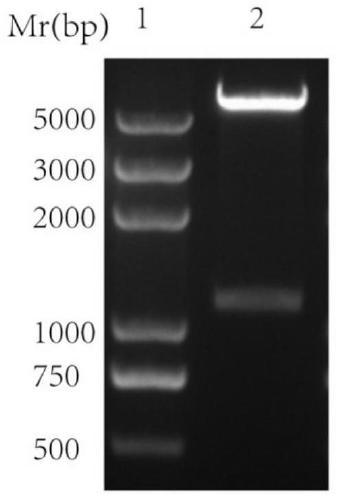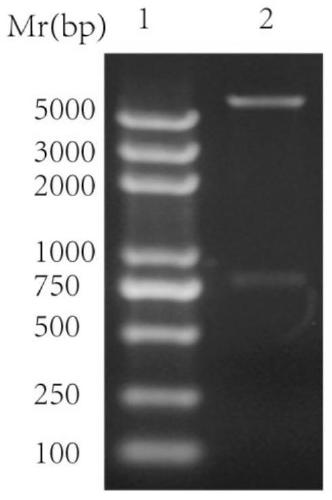Application of Simian Virus 40 Capsid Protein vp1 as Cell Penetrating Protein
A capsid protein, virus technology, applied in the field of cell transduction, can solve the problems of low efficiency, low practical utilization, strong damage and so on
- Summary
- Abstract
- Description
- Claims
- Application Information
AI Technical Summary
Problems solved by technology
Method used
Image
Examples
Embodiment 1
[0041] Simian virus 40 capsid protein VP1 gene, its preparation steps are as follows:
[0042] Using the pSV21SphI-N1 plasmid (Li et al, Small, 2009, 5:718-726) as a template, PCR amplification obtained the VP1 gene fragment of the simian virus 40 capsid protein, and the obtained VP1 gene sequence is shown in SEQ ID NO.1 , and the encoded amino acid sequence is shown in SEQ ID NO.2. The upstream primer used in PCR: VP1-S (NcoI): 5′CAGACCATGGATGAGAGGATCGCATCACCATCACCATCACGGATCTATGAAGATG 3′, the downstream primer: VP1-A (SacI): 5′GCTTGAGCTCGCACTGCATTCTAGTTGTGG 3′. PCR cycle conditions: denaturation at 94°C for 5 min; denaturation at 90°C for 1 min, annealing at 53°C for 40 s, extension at 72°C for 1 min and 30 s, and 30 cycle reactions; finally, extension at 72°C for 10 min. The amplified product was subjected to 1% agarose gel electrophoresis, the target band was excised under ultraviolet light, and the gel recovery and purification kit from Omega Company was used to recover. ...
Embodiment 2
[0044] Application of simian virus 40 capsid protein VP1 as a cell-penetrating peptide / verification of membrane penetration:
[0045] (1) CaCl for pET28a-hisVP1 plasmid 2 Transformed into E.coli Rosetta (DE3) competent cells by using the method, pick a single clone from the plate and put it into a 5mL LB test tube culture medium, and culture at 200r / min at 37°C overnight. The next day, transfer to 5mL LB test tube culture medium according to 1% inoculum amount, shake culture at 200r / min at 37°C overnight, transfer to 500mL LB Erlenmeyer flask the next day, and shake at 37°C at 200r / min until When the OD600 is between 0.4 and 0.6, add IPTG to a final concentration of 1 mM, continue to induce culture at 25 ° C for 8 h, collect the bacteria, and use loading buffer (25 mM Tris-HCl pH 7.8, 500 mM sodium chloride, 5 mM imidazole, 5% glycerol) washed once, resuspended in 40mL of binding buffer for sonication, centrifuged at 10000r / min for 30min, and the supernatant was loaded on the...
Embodiment 3
[0050] The application of monkey virus 40 capsid protein VP1 in the transduction of fluorescent protein mCherry into cells, the steps are:
[0051] (1) The fluorescent protein mCherry gene was inserted into the pET28a-hisVP1 vector through SacI and XhoI double restriction sites, and the plasmid pET28a-VP1mCherry was constructed, and the double restriction restriction plasmid was successfully constructed ( Figure 1-b ).
[0052] (2) The plasmid pET28a-VP1mCherry was transformed into E.coli Rosetta (DE3) competent cells. After the single clone was picked from the plate and expanded for culture, IPTG induced expression, and the fusion protein VP1- was purified by Ni2+-NTA column affinity chromatography. mCherry.
[0053] (3) fusion protein VP1-mCherry polyacrylamide gel electrophoresis, the molecular weight of VP1 protein is about 70kDa, the molecular weight of VP1-mCherry detected by polyacrylamide gel electrophoresis is consistent with the predicted value ( figure 2 Middle ...
PUM
| Property | Measurement | Unit |
|---|---|---|
| diameter | aaaaa | aaaaa |
| molecular weight | aaaaa | aaaaa |
| molecular weight | aaaaa | aaaaa |
Abstract
Description
Claims
Application Information
 Login to View More
Login to View More - R&D
- Intellectual Property
- Life Sciences
- Materials
- Tech Scout
- Unparalleled Data Quality
- Higher Quality Content
- 60% Fewer Hallucinations
Browse by: Latest US Patents, China's latest patents, Technical Efficacy Thesaurus, Application Domain, Technology Topic, Popular Technical Reports.
© 2025 PatSnap. All rights reserved.Legal|Privacy policy|Modern Slavery Act Transparency Statement|Sitemap|About US| Contact US: help@patsnap.com



